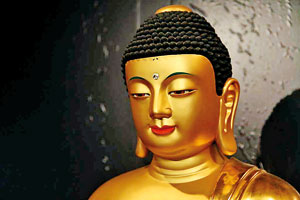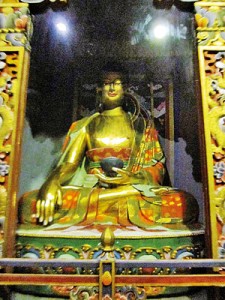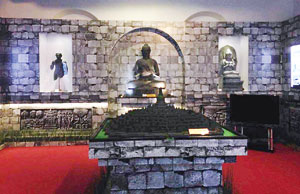Around the Buddhist world

Korea
The first-ever International Museum of World Buddhism was opened at the premises of the Sri Dalada Maligawa, Kandy on May 11, 2011 and since then has become a learning centre for University students and students following higher studies in Buddhism. The different galleries provide useful information on the history of Buddhism in different countries, both Theravada and Mahayana.
Secretary, International Affairs at the Sri Dalada Maligawa, Lionel Wijesundara, speaking to the Sunday Times on the construction and establishment of this museum said that initially the concept of a museum of Buddhist civilization was discussed by Prof. Senarat Paranvitana in the 1950s. Successive Diyawadana Nilames brought up this subject and it was Pradeep Nilanga Dela, the present Diyawadana Nilame, the lay custodian of the Sacred Tooth Relic, with the blessings of the Mahanayake Theras of the Malwatte and Asgiriya Chapters who was able to make this concept a reality.
The Diyawadana Nilame had told Mr. Wijesundara that as most Sri Lankans are unable to visit other Buddhist countries, which have a rich Buddhist culture, he felt the need to organise a museum with the participation of all the Buddhist countries in the world.
The site is the old Courts Complex behind the Sri Dalada Maligawa built in 1880, the ideal building for a museum of this magnitude. The museum and the galleries were ably planned by Prof. Leelananda Prematilake, former Head of the Department of Archaeology, University of Peradeniya. The consultancy work was done on a voluntary basis without any remuneration for his untiring efforts, perhaps considering it to be a meritorious act.
Prof. Prematilleke made a thorough study and designed the galleries of this two-storey building, taking into consideration the three main routes through which originally Buddhism spread in ancient India as well as modern Bangladesh and Pakistan, the Himalayan region of Nepal, Bhutan and Tibet.

Bhutan
The three main routes are: The South Asian route (ancient India and Sri Lanka); the South East Asian Route (Myanmar/Burma), Thailand (Siam), Cambodia, Laos, Vietnam, Malaysia and Indonesia) and the Northern Route (Afghanistan and Central Asia and the Far East including China, Taiwan and Japan).
In 2008, foreign missions, embassies and high commissions of countries historically associated with Buddhism were invited to join with the Maligawa authorities to make this museum a reality. There are some 18 galleries both of Theravada and Mahayana Buddhist countries spread over two floors.
At the entrance, on the way up to the building, large stone Buddha images from Malaysia, Cambodia and the Buddha image from Sri Lanka are displayed on the way up the stairway.
On the ground floor are the galleries of India, Bangladesh , Nepal, Bhutan, Pakistan, Afghanistan and Sri Lankan while Myanmar, Thailand, Cambodia, Laos, Indonesia, Malaysia, Korea, Japan, Central Asia, China, Tibet have their galleries in the upper floor.
The Foreign Missions had arranged for their own architects, engineers and craftsmen to come and work together with their Sri Lankan counterparts in setting up the museum.
Explanatory panels placed under the exhibits give the viewer a chance to discover more. Ten guides are available to lead the visitors and explain to them in detail the Buddhist heritage of each country.
The brochure of the Museum provides many details – how the Buddhist missionary activities of Emperor Asoka of India spread to many countries, including Sri Lanka as well as information on each country represented. We learn that though modern Bangladesh remains a Muslim country, there are important Buddhist sites there such as Badkhanta, Pahapoor, Rohitagiri.
The snow-clad Himalayan rock summit of Bhutan follows Mahayanism. Pakistan, ancient North-western India including Gandhara, Taxila and Peshawar has very valuable Buddhist monuments. A unique artistic creation is the stone sculptures of Gandhara depicting the history of the Buddha
Myanmar and Thailand, both Theravada followers, are well known for their meditating prelates. In Myanmar, the Swedagon stupa in Rangoon and many other Buddhist temples including the Ananda Vihara at Pagan are well known Buddhist monuments.

Indonesia
Cambodia is known for the world’s largest Mahayana shrine, the Bayon at Angkor Thom adorned with the heads of Lokesvara on the sikharas.
Laos was earlier a Theravada country now attracted to Mahayana. Vietnam is very much influenced by Cambodian and Laotian Buddhism, having lost much of its Buddhist culture due to the war.
Mainly an Islamic country, Malaysia was influenced by Buddhism prevailing in the neighbouring nations. Indonesia earlier known as Java has the celebrated Borobudur Stupa of Mahayana origin which is believed to be the largest stupa on a volcanic hill.
Well known Buddhist sites of Afghanistan are Hadda (ancient Nagarahara), Bamiyan with the world’s tallest Buddha image (now destroyed), and ranges of cave monasteries.
China has many Mahayana Buddhist sites. Monk travellers of China, Fa-Hsien and Huan-Thsang have historical connections with Sri Lanka and India.
Korea has produced magnificent temples with beautiful sculpture and murals. Japan which has a rich Buddhist heritage performs many Mahayana rituals. Kyoto city and Nara possess large monasteries with libraries and many other centuries -old Buddhist edifices.
With its interesting display of architectural and sculptural replicas, paintings and photographs depicting the ancient glories of Buddhist Art, the International Buddhist Museum at the Sri Dalada Maligawa, helps visitors to gain a better understanding and knowledge of the Buddhist world.


